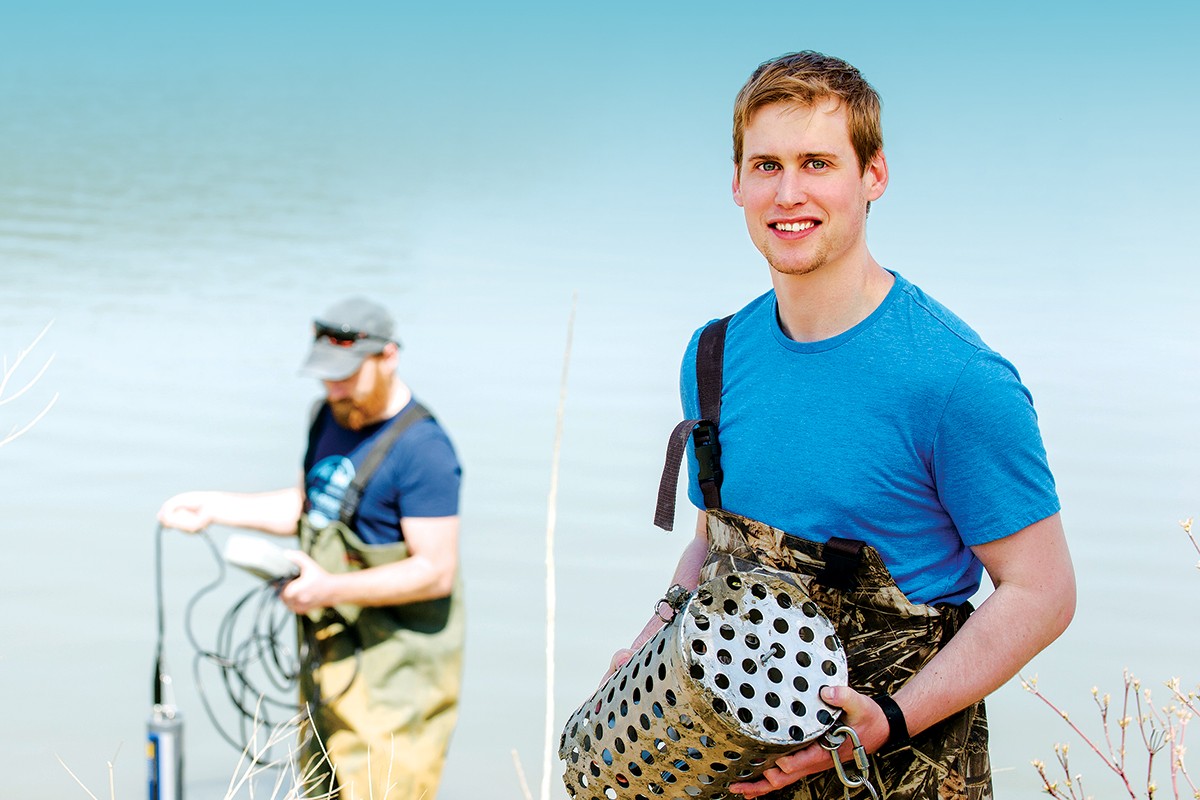
Jonathan Challis, PhD student in Chemistry, collecting water samples. // Photo by Ian McCausland
Water for life
A new generation of scientists partner for change
Graduate student Johanna Theroux banters with Norway House public health worker Carmen Anderson and guide Ken Budd as they mix chemicals from their kit with river water.
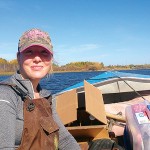
Johanna Theroux, a master’s student, collects sediment samples from the Jack River near Norway House. // Photo by Vanja Karpisek
“We have had such good luck with the people in the community being incredibly helpful,” Theroux said. “You need that local knowledge to get anything done.”
Achieving the human right to clean drinking water and safe wastewater disposal is a struggle in many parts of the world – from developing countries to Detroit, where residents complained to the United Nations last year after having their water service cut off. In Canada, drinking water security is mainly an issue in First Nations, with one in five facing tap water unfit to drink. Thousands of First Nation homes don’t even have plumbing – mainly in Manitoba and Northwestern Ontario. Bringing drinking water and wastewater infrastructure for all First Nations up to safe standards could cost almost $5 billion – unless innovators such as H2O engineering and science students discover more efficient methods.
The $3-million research-training program funded mainly by the Natural Sciences and Engineering Research Council of Canada has attracted Indigenous students interested in working with their own communities and other trainees such as Theroux who recognize the importance of learning from First Nations.
“Everybody seems really passionate about environmental issues… as opposed to a big city where you don’t get those conversations happening as much,” she said.
A previous generation of engineering and environmental consultants often lacked the social skills and cultural awareness to work effectively with First Nation communities but the H2O program aims to train a different kind of professional.
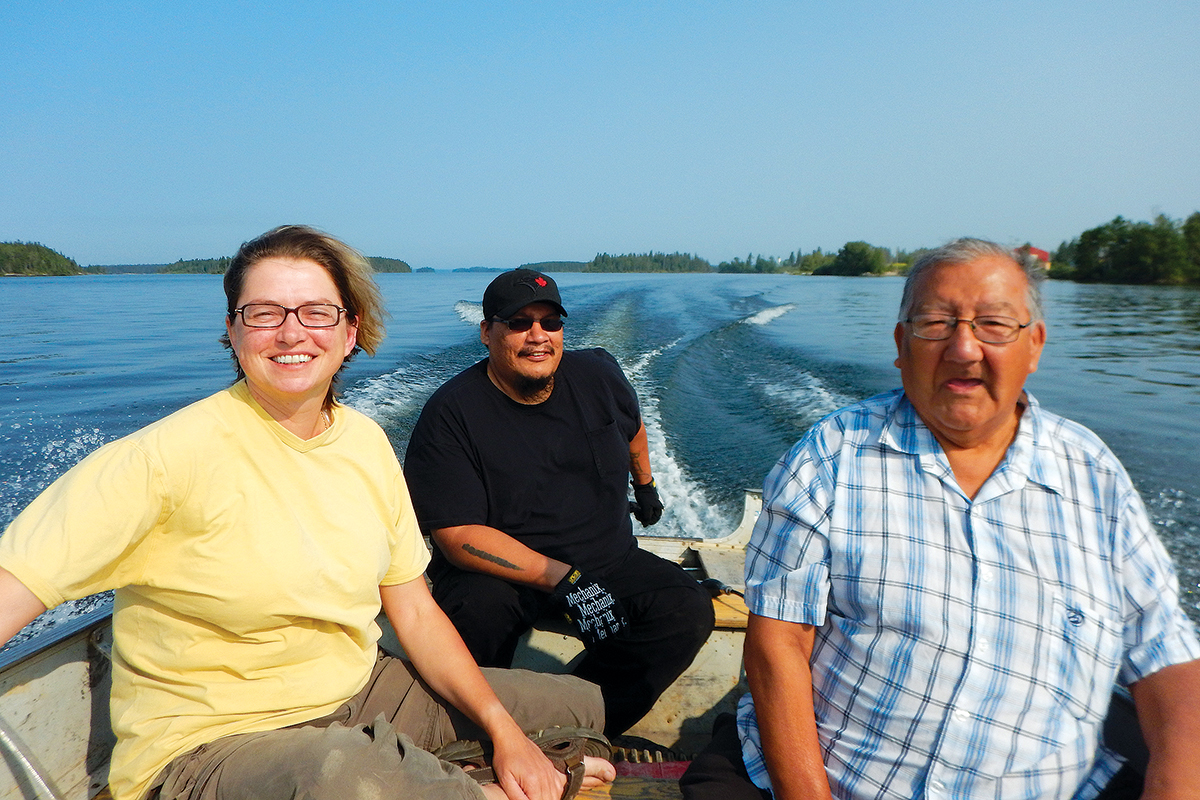
CREATE H2O director Dr. Annemieke Farenhorst, Waylon Hill Elder Russel Harper collect water samples from Island Lake, Manitoba. // Photo by Elizabeth Harries
The broadly multidisciplinary program exposes trainees to experts in law, economics and even psychology related to drinking water issues, partly through collaboration with a related social science project led by law Prof. Karen Busby. But it’s the Cree people who co-designed Theroux’s research project in Northern Manitoba who are having the greatest impact on her education.
“They’ve been phenomenal,” the graduate student said. Her advice to new trainees is to spend time in the First Nation communities where they’re working before starting research. It’s important to make a variety of connections so the project will run smoothly even in the face of turnover amongst band staff or council members.
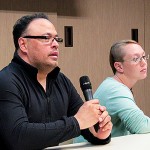
Councillor Gilbert Fredette and graduate student Johanna Theroux discuss Norway House research at the first University of Manitoba water rights conference. // Photo by Jared Wheeler
Norway House councilor Gilbert Fredette drove more than eight hours south to Winnipeg to speak at the first H2O student conference. His community lies at the mouth of the Nelson River, where every pollutant in Lake Winnipeg funnels past on its way to Hudson Bay.
“I’m very grateful to hear all the work that’s being done. I just want everybody to know that, as leaders, we are behind the researchers who are making these things public,” Fredette said.
Theroux says the river from which Norway House draws its drinking water had decent water quality in 2014 when river levels were high and hydro dams were wide open. She will investigate whether the water becomes murkier with lower water levels and will trace where the suspended sediment comes from. Communities count on independent university researchers to provide unbiased results.
“I’m very grateful to hear all the work that’s being done. I just want everybody to know that, as leaders, we are behind the researchers who are making these things public.”
A few hundred kilometres east of Norway House in a community accessible only by plane and boat or ice road, another H2O graduate student is investigating how waste disposal is affecting drinking water quality. Ahmed Oyegunle was baffled to find people living in conditions more familiar in his Nigerian homeland. “When it comes to seeing those situations in a country that is supposed to be developed, it’s so disheartening.”
“To hear personal experiences from many First Nations people about their local water supply (or lack thereof) … makes me want to work even harder to bring more communities in Manitoba clean water.”

Nora Whiteway helps master’s student Ahmed Oyengunle with research in Wasagamack. // Photo by Zackeus Harper
He said abandoned vehicles and a waste disposal site close to the lake are risky for the local drinking water supply, so he will help the community develop a waste disposal plan and try to access funding for cleanup.
He is excited about what the H2O program is doing for his budding career by improving his communication skills, helping him access specialized workshops and encouraging him to collaborate with people from so many disciplines and cultural backgrounds. “It brings people together in order to solve a problem.”
The impact of each H2O research project might seem like a drop in the bucket compared to the size of the problem but with so many people involved, the drops are starting to add up in a way students find satisfying.
“To hear personal experiences from many First Nations people about their local water supply (or lack thereof) … makes me want to work even harder to bring more communities in Manitoba clean water,” engineering graduate student Charles Goss said.
Cultural education that is key to this training program can also be fun. Oyegunle went ice fishing and attended his first powwow while living in Wasagamack for weeks at a time. PhD student Jonathan Challis found one of his research trips to Norway House coincided with York Boat Days, where he watched the races and ate pickerel, bannock and moose stew.

PhD student Jonathan Challis gets ready to deploy a passive sampler that measures wastewater quality over the course of several weeks. // Photo by Mark Hanson
The cultural exchange flows in many directions. PhD student Geethani Eragoda Arachchilage, who is Indigenous to her home country of Sri Lanka, brought small, carved elephants as gifts when she visited First Nations to test drinking water for bacteria. And trainees from different countries enjoy expanding their skills by helping out on each other’s research projects.
When he’s not eating bannock, Challis and his supervisor Mark Hanson install passive samplers that measure how effective Norway House’s new wastewater treatment plant is at reducing contamination before water is released back into the river system. So far, it looks like the plant is removing most of the nutrients that can cause algal blooms but the scientists are still working on results for emerging contaminants that treatment plants were never designed to address, such as pharmaceuticals and antibiotic resistance genes.
A team of professors, including Ayush Kumar, is supervising other H2O trainees who use cutting-edge DNA and RNA techniques to assess drinking water safety. They are comparing homes with water holding tanks to those with piped water, while tackling scientific challenges such as distinguishing between live and harmless dead bacteria and tracking the spread of antibiotic resistance. Kumar’s newest trainee is Taylor Morriseau, a member of Peguis First Nation completing a double honours degree in microbiology and genetics.
Meanwhile, Qiuyan Yuan is partnering with Aboriginal engineering firm BearPaw to design simple in-home ultraviolet drinking water treatment devices that might help in communities like Shoal Lake, Ontario, where there is no water treatment plant.
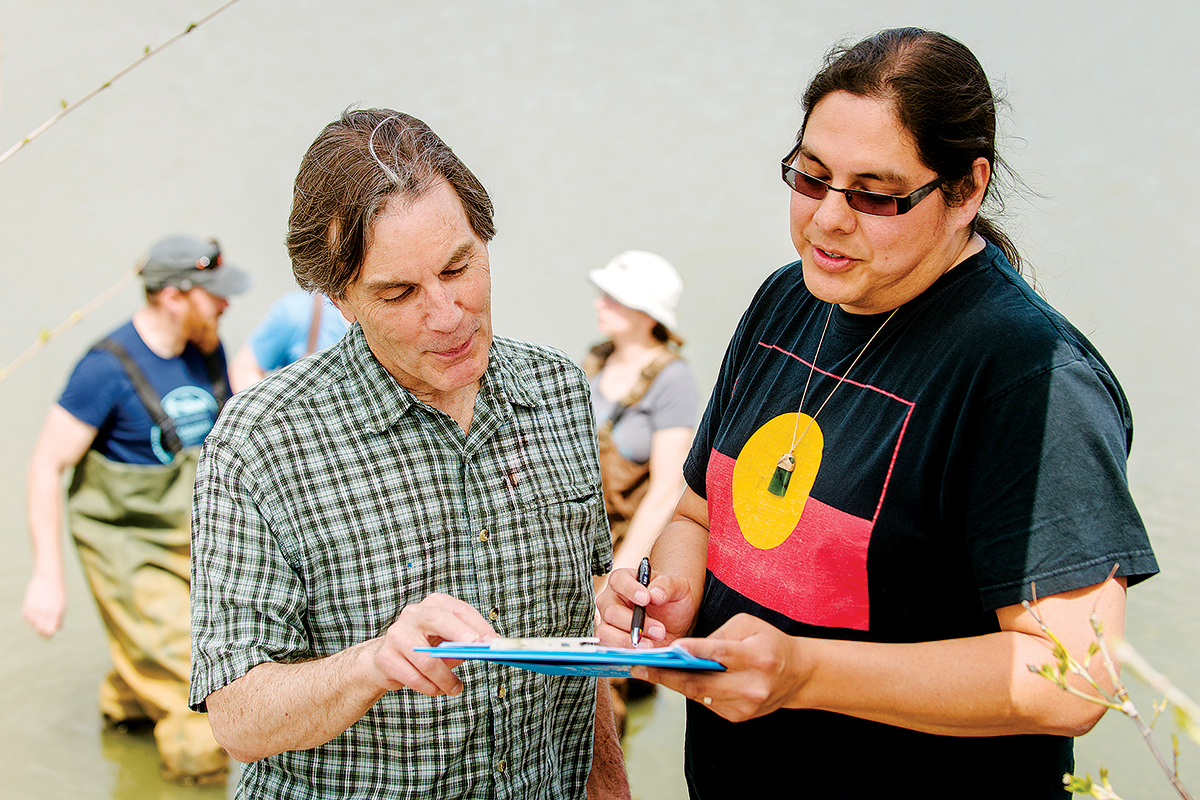
Michael Anderson and Brennan Manoakeesick from Manitoba Keewatinowi Okimakanak, CREATE H2O research partners. // Photo by Ian McCausland
CREATE H2O director Annemieke Farenhorst, and professor of soil science in the Faculty of Agricultural and Food Sciences, is especially excited about projects like these that have the potential to improve health in communities with poor water service.
“I teamed up with the university’s Centre for Human Rights Research to write the original grant proposal because I was moved by newspaper stories in 2010 that exposed serious drinking water problems in some Manitoba First Nations.”
“I teamed up with the university’s Centre for Human Rights Research to write the original grant proposal because I was moved by newspaper stories in 2010 that exposed serious drinking water problems in some Manitoba First Nations,” she said. The centre now houses the H2O program co-ordinator.
Shoal Lake has been in the news more recently as residents point out the irony of locating a national human rights museum in Winnipeg. The city draws its drinking water from their lake, while Shoal Lake residents are forced to bring in bottled water.
Other H2O research projects include watershed planning in advance of northern industrial development, preventing the formation of dangerous chlorine byproducts and testing better ways to treat sewage in cold climates. Student internships are underway this summer with a consulting firm and non-profit organizations.
This story was originally published in the Summer 2015 issue of Research Life.
Research at the University of Manitoba is partially supported by funding from the Government of Canada Research Support Fund.






